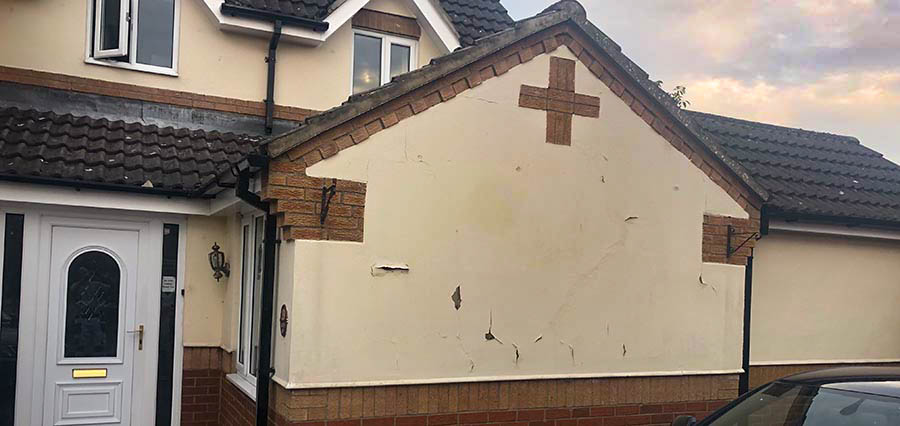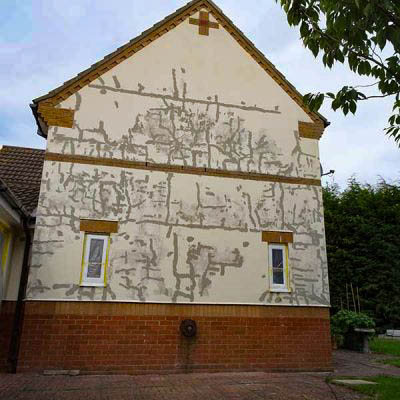When experienced professional decorator, Chris Kerfoot, was asked to re-paint a house on a street he had worked on many times before, he was confident he could deliver the same premium-grade finish.
The process should have been straightforward, as an identical exterior project to others he has done on that road, secured via word of mouth recommendation from the neighbours. But, as many painters and decorators know, when the tradesman before you has cut corners or skipped best practice, it can change the pace of a project, double your workload and add lengthy delays to your completion date. This is exactly what happened to Chris on this project.
Here, he details the moment he realised he had his work cut out, and how he overcame the challenges.

When a homeowner employs you on the recommendation of their neighbours, to complete a project identical to the one they had done, the expectation is that it will be a stress-free experience. That is not always the case. Each property is different and that was the case here.
Before repainting a rendered property, it is critical to correctly clean the render to remove discolouration and kill residual mould. We use sodium hypochlorite (chlorine) mixed with clean water, which we apply using a pressure sprayer. Skipping this step is a common mistake and will have a significant effect on the results and longevity of the new paint job.
Once the chlorine has been applied, we neutralise it and rinse away the dirt with a pressure washer fitted with a turbo nozzle. Here’s where the problems started. After about an hour, the pressure washer began to leak, rendering it useless, and bringing the project to a stop.
If you experience an equipment failure, it is important to firstly manage your customers expectations. Tell them straight away, don’t let them wonder why work has stopped so abruptly.
If you have colleagues or industry acquaintances locally, call them to see if they have similar equipment which could help you finish this job and buy you time to seek a professional repair or replacement part for your kit.
Failing that, try local merchants or hire companies who can often help get things back up and running quicker than you might expect.
Cleaning the surface of the old render with a simple routine cleaning process uncovered the most hairline cracks we had ever seen on a single project. Upon further inspection it became apparent that the previous painter had uncovered the same issue, but instead of fixing the problem properly, they had simply smeared caulk over the fractures and painted the house. This is not best practice and a short-term solution at best, so we knew we had to put it right, properly.

Cleaning the surface of the old render with a simple routine cleaning process uncovered the most hairline cracks we had ever seen on a single project. Upon further inspection it became apparent that the previous painter had uncovered the same issue, but instead of fixing the problem properly, they had simply smeared caulk over the fractures and painted the house. This is not best practice and a short-term solution at best, so we knew we had to put it right, properly.
If you uncover challenges like this which will extend the timeframe of the project, incur additional labour time and material costs, have an honest and upfront discussion with your customer at the earliest convenience.
There are a number of factors to consider before this conversation so that you have a clear idea in your mind of what you’d like the outcome to be. Do you need to charge more for this additional work? Have you got time to complete it before your next project begins? Is it something you are willing to do as a good will gesture to secure further word of mouth recommendations?
Once you’ve solved the matter of time and expense with your customer, choose the right method for fixing the problem. Research is key, so that you don’t leave behind another botched job for the next painter. Help is available online, or you could ask fellow industry colleagues for their advice. We raked out the hairline cracks and applied Toupret Touprelith F masonry repair filler. To achieve a textured finish which would blend in with the render across the rest of the house, we dampened the filler when almost dry and rubbed it with a tiling foam flout using circular motions.
Crucially, we kept the customer informed all the way through, so that they were reassured of a professional finish this time around. They were impressed with the technique we used and were happy to see the products we had purchased, knowing that they were the right products for the job this time around.
With the challenges overcome we were on the home straight. We masked the perimeter of the double glazing with Q1® Precision Line Masking Tape to ensure a razor-sharp paint line across the property. On top of that tape, we applied Q1® Pre-Taped Washi Film and unfolded the sheet to cover all windows and doors thoroughly. We used Q1®’s Multiple Purpose Tape to seal the loose edges.
We used Johnstone’s Stormshield Masonry Paint, applied with a brush. Firstly, we applied a thin coat across the hairline cracks and then completed the job with two complete coats.
Finishing the project was easy, with Q1® peeling away with ease and absolutely no residue, despite the hot summer conditions and exposure to direct sunlight for most of the application time.

Despite the considerable challenges of this project, the customer was left satisfied with both the service and the result. Let us recap those key tips for overcoming challenges to deliver customer satisfaction:
To hear more from Chris Kerfoot, listen to his podcast here. To discover Q1®’s range of masks, papers and films, click here.
Let’s get in touch.
Keeping excellent masking products in your shop means selling efficiency and high productivity to your customers. Join the Q1® family to watch your business grow.